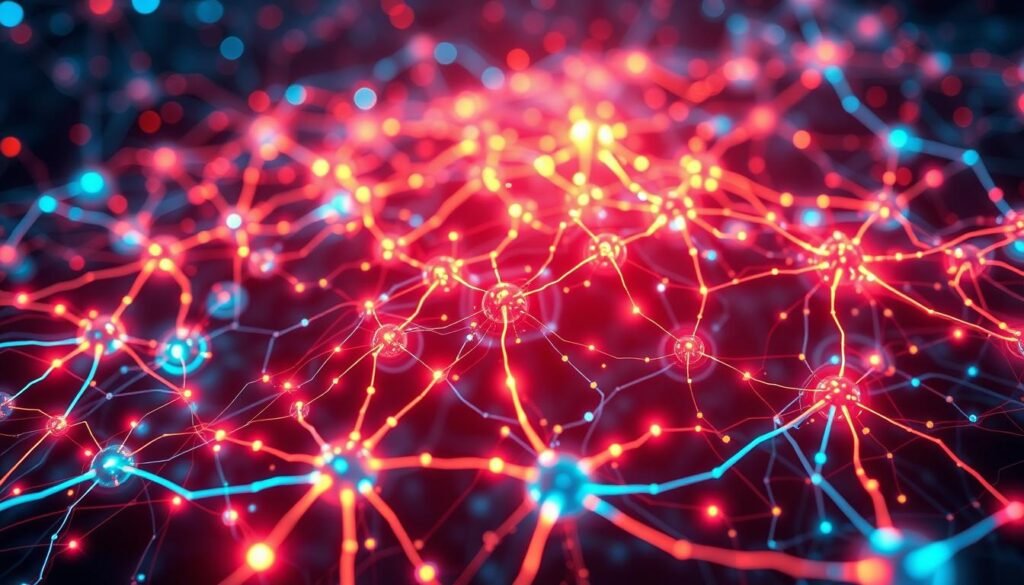Did you know traditional AI systems need a lot of power? But, neuromorphic chips aim to use less energy. This new way is like the human brain and could change tech and computing a lot. You can use ai based synaptic models to make your systems better and more agile. This is key for modern tech.

Exploring ai based synaptic models shows how they work like our brains. Neuromorphic computing, inspired by our brains, brings a new way to compute. It promises big gains in AI and data processing speed. By learning about ai based synaptic models, you can open new doors for your business. You’ll stay on top of tech changes, thanks to neural networks and AI algorithms.
Key Takeaways
- AI-based synaptic models are inspired by the human brain and aim to revolutionize technology and computing.
- Neuromorphic chips operate at lower energy levels and can handle multiple processes simultaneously, speeding up computations.
- AI-based synaptic models can learn and evolve from new data inputs on their own, unlike traditional systems.
- Neural network architectures and artificial intelligence algorithms are crucial in developing these models.
- AI-based synaptic models have the potential to improve the efficiency and agility of your systems.
- Neuromorphic computing promises unprecedented efficiency and agility in artificial intelligence and advanced data processing.
Understanding AI-Based Synaptic Models and Their Foundation
Exploring AI-based synaptic models means diving into their foundation and biology. It’s about seeing how machine learning techniques and deep learning models create these models. They are inspired by cognitive computing systems. AI’s role in the nervous system, like in diagnostics and pain management, mirrors how these models work.
The science behind synaptic computing is based on neuroplasticity. This is how connections between brain cells change based on activity. This idea guides the design of artificial neural networks (ANN), which mimic the brain’s neural networks.
- Long-term Potentiation (LTP): Repeated stimulation increases synaptic strength in neural networks.
- Long-term Depression (LTD): Weakening of synaptic connections due to low-frequency neural activity.
- Myelination: Strengthens neuron connections for memory encoding, consolidation, and retrieval.
Knowing the biology of synaptic computing and the use of machine learning techniques and deep learning models helps us see their potential. They can be used in medicine and technology. They help us understand human biology better and improve our lives.
Revolutionary Applications in Modern Technology
Exploring AI-based synaptic models reveals their groundbreaking uses in today’s tech. They are key in neurocomputing applications and computational neuroscience research. These models could change many areas, like healthcare and finance, by making computing better and more flexible.
Spiking Neural Networks (SNNs) mark a big step forward. They can change AI by solving problems like energy use and hardware needs. SNNs promise to make computing more precise and efficient in computational neuroscience research.
Some main advantages of SNNs are:
- Energy efficiency
- Advanced hardware compatibility
- Temporal processing capabilities

In neurocomputing applications, SNNs help create smarter systems. These systems can better understand and interact with their surroundings. This could lead to big leaps in healthcare and environmental monitoring.
How AI-Based Synaptic Models Transform Data Processing
Exploring AI-based synaptic models reveals their impact on data processing. They use artificial intelligence algorithms and neural network architectures. This leads to better pattern recognition, real-time learning, and faster processing.
At the Institute of Nano Science and Technology (INST), Mohali, a special chip was made. It shows neuromorphic and resistive switching behaviors. It also has the needed optoelectronic properties for tasks like sensory perception and memory.
Some key benefits of AI-based synaptic models include:
- Enhanced pattern recognition capabilities
- Real-time learning and adaptation
- Energy efficiency improvements
- Processing speed advancements

AI-based synaptic models change data processing for the better. They make it more efficient and powerful. This technology could change many areas, like healthcare, education, and the environment, making life better for everyone.
| Application | Benefit |
|---|---|
| Healthcare | Improved disease diagnosis and treatment |
| Education | Personalized learning experiences |
| Environmental Sustainability | More efficient resource management |
Implementing Synaptic Models in Your Business Environment
To integrate cognitive computing systems and deep learning models, assess your current setup. Look at your systems, data management, and workflows. This helps you see where synaptic models can make a big difference. You can then plan how to implement them based on your business needs.
Using synaptic models can boost your business in many ways. For example, cognitive computing systems can analyze customer data to offer personalized suggestions. Meanwhile, deep learning models can spot issues in operations and suggest maintenance before problems arise.
Here are steps to consider when adding synaptic models to your business:
- Evaluate your current infrastructure and identify areas for improvement
- Assess your data management processes and determine how synaptic models can be used to enhance them
- Develop a roadmap for implementation that is tailored to your specific business needs
- Provide training and support for employees to ensure a smooth transition
By following these steps and using cognitive computing and deep learning, you can grow and innovate.
Conclusion: Embracing the Synaptic Computing Revolution
The arrival of AI-based synaptic models is changing the game in computing and tech. These models, inspired by the brain, bring new powers in pattern recognition, real-time learning, and energy efficiency. By using artificial intelligence algorithms, you can open up new possibilities for your business.
The path to ai based synaptic models is thrilling and full of promise. It’s a time for better decision-making and predictive tools. It’s also a chance to make big strides in healthcare and finance. Stay ahead by learning about and using these advanced technologies.
FAQ
What are AI-based synaptic models and how do they work?
AI-based synaptic models are inspired by the human brain’s neural networks. They use machine learning and deep learning to mimic brain functions. This helps in creating smart computing systems.
What is the biological basis of synaptic computing?
Synaptic computing is based on how our brains process information through neural connections. AI models these processes to create efficient computing solutions. They have many uses, including in medicine.
How can AI-based synaptic models revolutionize modern technology?
These models could change many fields like healthcare and finance. They offer better computing solutions. This leads to new advancements in neurocomputing and neuroscience research.
How do AI-based synaptic models enhance data processing capabilities?
These models use neural networks and AI to improve data processing. They enhance pattern recognition and adapt quickly. This makes data processing faster and more efficient across industries.
What are the key considerations when implementing synaptic models in a business environment?
Adding AI-based synaptic models to businesses can bring many benefits. It can improve operations and customer service. But, it’s important to carefully plan the integration to make it work well.
Also Read
